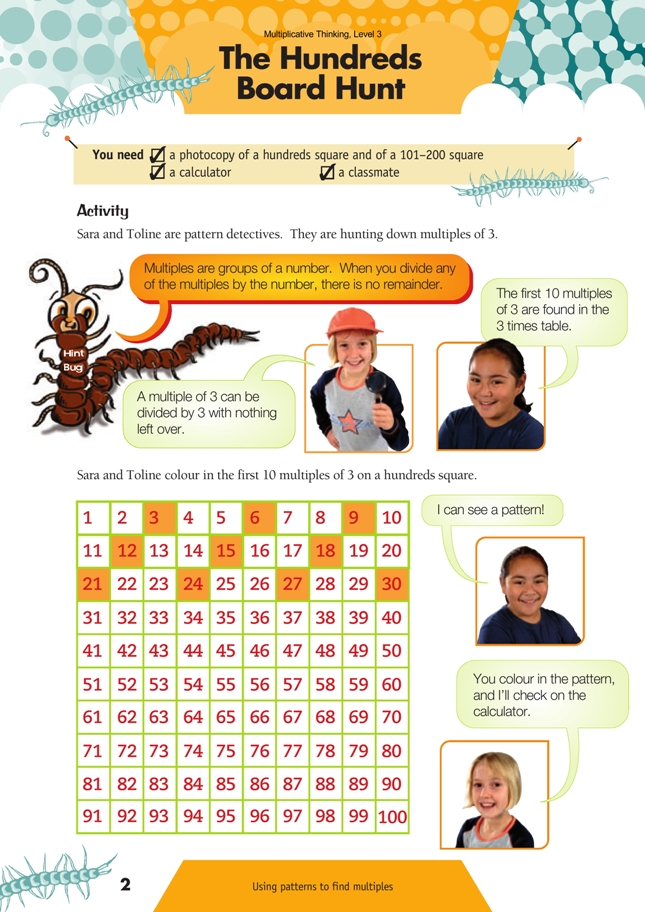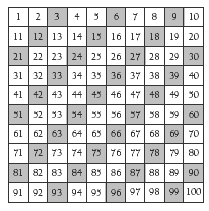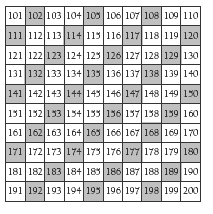This is a level 3 and 4 number activity from the Figure It Out series. It relates to Stage 6 and 7 of the Number Framework.
A PDF of the student activity is included.
Click on the image to enlarge it. Click again to close. Download PDF (857 KB)
explore patterns of multipes of 3
explore divisibility rules
Number Framework Links
Use this activity to develop your students’ knowledge of multiples of 3. They can use this knowledge to help them devise multiplicative part–whole strategies (stages 6–7).
FIO, Level 3, Multiplicative Thinking, The Hundreds Baord Hunt, pages 2-3
A calculator
A classmate
In this activity, students colour a hundreds square to explore patterns in the 3 times table. They then discover that if they add the digits of any multiple of 3, the result is a number that is also divisible by 3. (For example: 54 is a multiple of 3, and 5 + 4 = 9, which is divisible by 3.)
For large numbers, they may need to repeatedly add the digits until they get a single digit, known as the digital root of that number. (For example, the digital root of 756 is 9 because 7 + 5 + 6 = 18 and 1 + 8 = 9, which is divisible by 3.)
Before the activity, discuss what multiples are. (You can use the definitions and examples on the student page.) A good introduction is to play a game of Yes or No, where the students decide whether given numbers are multiples of 5 or not. Talk about what you would expect to show up on the calculator if you entered ÷ 5 = and if was a multiple of 5. (The calculator would show a whole number.) Compare this to the result if wasn’t a multiple of 5. (The calculator would display a decimal fraction.) (See the Numeracy Development Project [NDP] activity, In and Out, page 36, Book 4: Teaching Number Knowledge.)
Nines and Threes (Book 6: Teaching Multiplication and Division, page 38) uses place value materials to help students understand why it is that the digit total of a multiple of 3 is also a multiple of 3.
Extend the activity by investigating other divisibility rules. For stage 7:
• multiples of 2 have 0 or an even number in the ones place
• multiples of 5 have 0 or 5 in the ones place
• for multiples of 9, if you keep adding the digits in the multiple until you get a single digit, it will be 9 (this is its digital root), for example, 693: 6 + 9 + 3 = 18, 1 + 8 = 9
• multiples of 10 have 0 in the ones place.
For stage 8:
• multiples of 4 are always even, and if you look at only the tens and the ones places, that number will be a multiple of 4; for example, 1 328 is a multiple of 4 because 28 is divisible by 4. This works because all digits in the hundreds place and above represent multiples of 100, which is itself divisible by 4.
• multiples of 6 are always even and have a digital root that is divisible by 3 (that is, they are divisible by both 2 and 3)
• multiples of 8 are always even, and if you look at only the hundreds, tens, and ones places, that number will be a multiple of 8. For example, 7 624 is a multiple of 8 because 624 is divisible by 8. This works because all digits in the thousands place and above are multiples of 1 000, which is itself divisible by 8.
Answers to Activity
1. a. Descriptions may vary. The pattern is a diagonal one, with two uncoloured diagonals after each coloured diagonal.
b. Practical Activity
c. 3 + = = = = … (or 3 + + = = = = …) will give you all the multiples of 3. Alternatively, if you divide each of the coloured-in numbers by 3 on your calculator, the answer will be a whole number.
2. a. 102. (102 ÷ 3 = 34. There is no remainder.)
b. 198. The last multiple must be one of the last 3 numbers on the square. 198 is divisible by 3 with no remainder, but 199 and 200 aren’t.
c. Practical activity
3. Answers will vary. One simple rule (generalisation) is: a number is a multiple of 3 if
all its digits add up to a number that is a multiple of 3. For example, for 147,
1 + 4 + 7 = 12. 12 is divisible by 3 (12 ÷ 3 = 4), so 147 is a multiple of 3 (147 ÷ 3 = 49).
Note: If your addition gives you a number with two or more digits and you are not sure if it is divisible by 3, add up the new digits: if the number is divisible by 3, your final answer must be 3, 6, or 9. For example, for 198: 1 + 9 + 8 = 18, 1 + 8 = 9.
4. Numbers tried will vary. The rule and the note in question 3 still apply. For example, for 2 835: 2 + 8 + 3 + 5 = 18, 1 + 8 = 9; and for 9 864: 9 + 8 + 6 + 4 = 27, 2 + 7 = 9. On the calculator, all multiples of 3 will have whole-number answers
when divided by 3.



